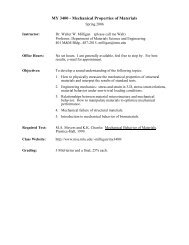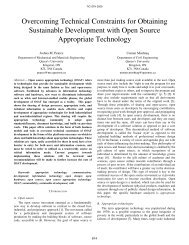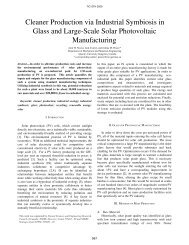Underfill Flow as Viscous Flow Between Parallel Plates Driven - Profile
Underfill Flow as Viscous Flow Between Parallel Plates Driven - Profile
Underfill Flow as Viscous Flow Between Parallel Plates Driven - Profile
Create successful ePaper yourself
Turn your PDF publications into a flip-book with our unique Google optimized e-Paper software.
134 SEEE TRANSACTSONS ON COMPONENTS, PACKAGING. AND MANUFACTURING TECHNOLOGY-PART C, VOL. 19, NO. 2, APRIL 1996<br />
Substituting (3) into (4), integrating and solving for /3 gives<br />
12p dL<br />
pr- - (5)<br />
h2 (dt).<br />
By substituting (5) into (2a), the head loss (@/ax) can be<br />
expressed by the partial differential equation<br />
ap - 12p dL<br />
---&E) dx<br />
The Laplace-Young equation of capillarity states that the<br />
pressure drop across the free surface of a liquid-vapor interface,<br />
from the concave side to the convex side, is inversely<br />
proportional to the radius of curvature of the free surface [17],<br />
[18]. The radius of curvature of the free surface for the two<br />
dimensional c<strong>as</strong>e can be shown to be h/2cosO, where Q is<br />
the wetting angle that the underfill makes with the planes (see<br />
Fig. 2). From the Laplace-Young equation, the pressure drop<br />
across the free surface (Ap) can be expressed <strong>as</strong><br />
27 cos e<br />
Ap = ~<br />
(7)<br />
h<br />
where y is the surface tension of the liquid-vapor interface.<br />
Since dL/dt is independent of x and dpldx is independent of<br />
t, (6) can be separated into two ordinary differential equations<br />
*=r<br />
dx<br />
where r is a constant. Since the boundary condition at x = L<br />
is on the convex side of the interface plx=~<br />
= -Ap. Solving<br />
(8a) subject to the boundary conditions<br />
gives<br />
2y COS 0<br />
Pjx=o = 0, P l d = -~ h<br />
27 cos 6'<br />
r=-- (9)<br />
hL '<br />
Substituting (9) into (8b) and solving subject to the conditions<br />
Llt=o = 0, Llt=t, = Lf<br />
where tf is the flow time and Lf is the flow distance gives<br />
12& - 2ycos6'<br />
~- ~<br />
-<br />
h2 2<br />
h tf.<br />
Rearranging (10) and dropping subscripts gives<br />
hty cos 0<br />
Alternatively, solving (1 1) for the flow time gives<br />
3pL2<br />
t=- hy cos 6' '<br />
The flow time for viscous flow between parallel plates driven<br />
by capillary action is inversely proportional to the surface<br />
tension, separation distance, and the cosine of the wetting<br />
angle, and directly proportional to the viscosity and the square<br />
of the flow distance.<br />
The quantity (y COS 6')/2p me<strong>as</strong>ures the penetrating power<br />
of a liquid into a horizontal capillary tube, and w<strong>as</strong> defined<br />
by W<strong>as</strong>hburn [19] <strong>as</strong> the coeficient of penetrance. Since<br />
underfill flow under flip-chips more closely resembles flow<br />
between parallel plates, we can define an analogous term <strong>as</strong><br />
the coejjicient of planar penetrance (a), <strong>as</strong><br />
(y cos 6')/3p. (13)<br />
This parameter me<strong>as</strong>ures the penetrating power of a liquid<br />
into a gap between parallel plates, and h<strong>as</strong> units of velocity.<br />
Substituting the coefficient of planar penetrance into (1 1) and<br />
(12) gives<br />
and<br />
L=V%% (14)<br />
t = L2/@h. (15)<br />
In practice, most underfill materials wet the parallel plate<br />
surfaces, resulting in near zero wetting angles <strong>as</strong> can be seen<br />
in Fig. 1. In this c<strong>as</strong>e, cos 6' M 1, leaving y/3pL. Assuming ideal<br />
wetting, the penetrating power of a liquid into a gap between<br />
parallel plates is characterized by 113 of the ratio of the surface<br />
tension of the liquid to its viscosity. Since this parameter may<br />
be strongly related to the temperature of the underfill material,<br />
it should be me<strong>as</strong>ured and specified at the recommendedflow<br />
temperature, which is often higher than room temperature.<br />
111. EMPIRICAL VERIFICATION OF THE MODEL<br />
The exact relationship developed in (14) w<strong>as</strong> verified experimentally.<br />
The surface tension and viscosity of a typical filled<br />
epoxy underfill material were me<strong>as</strong>ured and used to calculate<br />
the coefficient of planar penetrance (a). This value w<strong>as</strong> then<br />
substituted into (14) to calculate the flow distance (L). The<br />
actual flow distance of the underfill material w<strong>as</strong> determined<br />
by Bowing the underfill between parallel plates. The model<br />
w<strong>as</strong> verified by comparing the flow distance predicted by (14)<br />
to the actual flow distance from the parallel plate flow test.<br />
The viscosity of the underfill material w<strong>as</strong> characterized<br />
with a temperature controlled rheometer. A 4.0 cm parallel<br />
plate with a gap of 175 pm w<strong>as</strong> used. The viscosity w<strong>as</strong> a<br />
very strong function of temperature. The viscosity w<strong>as</strong> nearly<br />
constant over a shear stress range of 20 to 100 Pa, indicating<br />
highly Newtonian behavior. A viscosity of 0.775 kglms w<strong>as</strong><br />
me<strong>as</strong>ured at a temperature of 80"C, and a shear stress of 100<br />
Pa.<br />
The surface tension of the underfill material w<strong>as</strong> determined<br />
experimentally by me<strong>as</strong>uring the capillary rise in 0.50 mm<br />
diameter gl<strong>as</strong>s capillary tubes at 80°C. Using a receding<br />
meniscus, a value of 0.036 N/m w<strong>as</strong> me<strong>as</strong>ured. Using a<br />
progressing meniscus, a value of 0.015 N/m w<strong>as</strong> me<strong>as</strong>ured.<br />
Since underfill flow involves a progressing meniscus, the value<br />
of 0.015 Nlm from the progressing meniscus w<strong>as</strong> substituted<br />
for the ycos6' term in the calculation of the coefficient of<br />
planar penetrance. The use of this value <strong>as</strong>sumes that the<br />
surface of the capillary tube is similar <strong>as</strong> the surfaces of the<br />
parallel plates.








